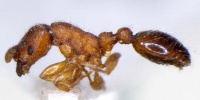Vollenhovia menshen
| Vollenhovia menshen | |
|---|---|

| |
| Scientific classification | |
| Kingdom: | Animalia |
| Phylum: | Arthropoda |
| Class: | Insecta |
| Order: | Hymenoptera |
| Family: | Formicidae |
| Subfamily: | Myrmicinae |
| Tribe: | Crematogastrini |
| Genus: | Vollenhovia |
| Species: | V. menshen |
| Binomial name | |
| Vollenhovia menshen Terayama, 2009 | |
Nothing is known about the biology of Vollenhovia menshen.
Identification
Terayama (2009) - This species resembles Vollenhovia emeryi, distributed from Hokkaido to Yakushima island in Japan, but is separable from the latter by the much developed lamellar wall of subpetiolar process and the absence of distinct propodeal spines.
Distribution
Distribution based on Regional Taxon Lists
Oriental Region: Taiwan (type locality).
Distribution based on AntMaps
Distribution based on AntWeb specimens
Check data from AntWeb
Countries Occupied
| Number of countries occupied by this species based on AntWiki Regional Taxon Lists. In general, fewer countries occupied indicates a narrower range, while more countries indicates a more widespread species. |

|
Estimated Abundance
| Relative abundance based on number of AntMaps records per species (this species within the purple bar). Fewer records (to the left) indicates a less abundant/encountered species while more records (to the right) indicates more abundant/encountered species. |

|
Biology
Castes
Terayama (2009) - Females (queens) of V. emeryi are all alate, while this species produces ergatoid females.
Nomenclature
The following information is derived from Barry Bolton's Online Catalogue of the Ants of the World.
- menshen. Vollenhovia menshen Terayama, 2009: 148, fig. 204 (w. ergatoid q.) TAIWAN.
Unless otherwise noted the text for the remainder of this section is reported from the publication that includes the original description.
Description
Worker
Head microreticulate, 1.19 times as long as wide, with concave posterior margin. CI = 84, SI = 71, eye 0.13 mm in diameter. Promesonotum densely punctate, promesonotal dorsum almost straight, metanotum very weakly concave in profile; prosterodorsal corner of propodeum with an angle. Petiolar node higher than long, with convex dorsal margin, posterolateral corner not forming an angle, subpetiolar process developed, its thin lamellar wall higher than long. Postpetiole higher than long, dorsal outline convex in profile. Gaster smooth and shining.
HL 0.63, HW 0.53, SL 0.38, WL 0.78, PL 0.20, PH 0.33, DPW 0.20, PPL 0.20, PPH 0.23, PPW 0.20, TL 2.5
Color. Reddish brown; frons with a large brown spot; alitrunk and pedicel reddish brown; gaster blackish brown.
Type Material
Holotype. Worker, Nanshanxi, Nanfen-Cun, Nantou Pref., 30. vii. 1986, M. Terayama leg. Paratypes. 2w, same data as the holotype, 2w, 1 ergatoid female, same locality, 28.vii.-3.iii. 1988, 1w, Wushe, Nantou Pref., 23. viii. 1987, M. Terayama leg. Types are preserved in NIAES.
Etymology
The specific epithet is the Chinese noun Menshen, which is the name of a Taiwanese god.
References
References based on Global Ant Biodiversity Informatics
- Guénard B., and R. R. Dunn. 2012. A checklist of the ants of China. Zootaxa 3558: 1-77.
- Terayama M. 2009. A synopsis of the family Formicidae of Taiwan (Insecta: Hymenoptera). Research Bulletin of Kanto Gakuen University. Liberal Arts 17:81-266.
- Terayama Mamoru. 2009. A synopsis of the family Formicidae of Taiwan (Insecta, Hymenoptera). The Research Bulletin of Kanto Gakuen University 17: 81-266.
- Terayama, M. 2009. A synopsis of the family Formicidae of Taiwan (Insecta; Hymenoptera). The Research Bulletin of Kanto Gakuen University 17: 81-266.

